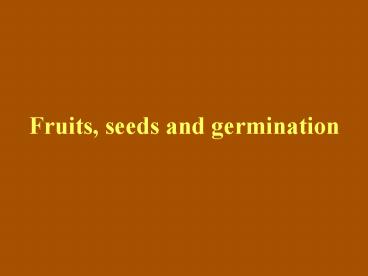Fruits, seeds and germination - PowerPoint PPT Presentation
1 / 13
Title:
Fruits, seeds and germination
Description:
Fruits, seeds and germination Embryo forms from upper part of the zygote Fig. 31.7a-d, p. 536 Globular stage Heart -shapped stage vacuole nucleus Single celled zygote ... – PowerPoint PPT presentation
Number of Views:88
Avg rating:3.0/5.0
Title: Fruits, seeds and germination
1
Fruits, seeds and germination
2
Fig. 31.7a-d, p. 536
3
Triploid (3n) tissue provides for rapid
production of nutrients and growth hormones for
the developing embryo
Fig. 31.7e -g, p. 536
4
Three types of seed
Dicot Endosperm is used in formation of
cotyledons during seed formation
Dicot Endosperm remains as a food source in the
seed for use at germination
Monocot Endosperm is a food source in the seed
for use at germination
5
Storage parenchyma in bean cotyledon
- The purple structures are starch grains.
- What is this tissue stained with?
http//www.uri.edu/artsci/bio/plant_anatomy/images
.htmllab_1
6
Cross section of the seed coat of a bean
Macrosclereids
Osteosclereids
Macrosclereids column shaped, longer than
wide Osteosclereids bone shaped, elongated with
swollen ends
7
Correspondence between flower and fruit in the
pea plant
Stigma
Seed
Ovule
Pericarp
Ovary wall
8
Types of Fleshy Fruits
Single ovary of one flower
Simple
Many ovaries of one flower
Aggregate
Many ovaries of many flowers
Multiple
9
Germination involves 4 major processes
- Hydration (or imbibition) - Seeds must take up
water. A seed will absorb water only if the seed
coat and / or other coverings are permeable.
Water is absorbed by osmosis, driven by the
existence / buildup of high solute concentration
in the seed cells.
- Breaking dormancy which initiates metabolism.
- Enzyme activation - soon after seed hydration,
respiratory enzymes are activated, and food
reserves, such as starch, are metabolized to
produce the fuel (mostly ATP) for synthesis of
other enzymes needed for such growth.
4) Carbohydrate, fat and protein reserves in the
cotyledons or endosperm are mobilized to
support the renewed development of the embryo.
10
Nutrient mobilization during germination of
barley seed
Hordeum vulgare L
Maltose
The embryo releases hormones called gibberellins
as signals to the aleurone, the thin outer layer
of the endosperm. The aleurone synthesizes and
secretes enzymes that hydrolyze starch
11
Steeping
Adding water, the steeping process, is to start
germination. Germination is activated when
moisture levels in the barley (12 - 13) are
brought up to 43 - 45. The steeped barley
requires periods of rest and aeration in order to
provide adequate oxygen for germination. Steep
cycles last approximately 44 hours.
12
Brewing
A mash of water and malted barley is heated,
activating enzymes naturally present in the
malted barley, causing it to convert starch into
sugar which the brewing yeast can later ferment.
The mash is pumped into a brewing vessel where
barley husks are filtered out. When the sugary
water, "wort" has completely dripped through the
husks, absorbing their flavour, the husks are
removed and the boil begins. (Husks are sold as
cattle feed.)
The boil is where the unique hop flavour is
added. Varying the type and quantity of hops is
what gives each beer its particular flavour and
aroma.
After settling, the wort is cooled, then pumped
into fermentation tanks where yeast is added. The
yeast uses the sugar in the wort to create
alcohol and carbon dioxide.
13
Michelob ULTRA, the latest brand from
Anheuser-Busch, is a smooth, refreshing lager
with 95 calories, 4.2 percent alcohol by volume
and 2.6 grams of carbohydrates per 12-oz.
serving.
Michelob ULTRA is brewed using the finest pale
two-row and Munich six-row barley, select grains,
all-imported hops and a pure cultured yeast
strain.
The special choice of grains, combined with the
extended mash process, produces a smooth,
refreshing beer with fewer carbohydrates































